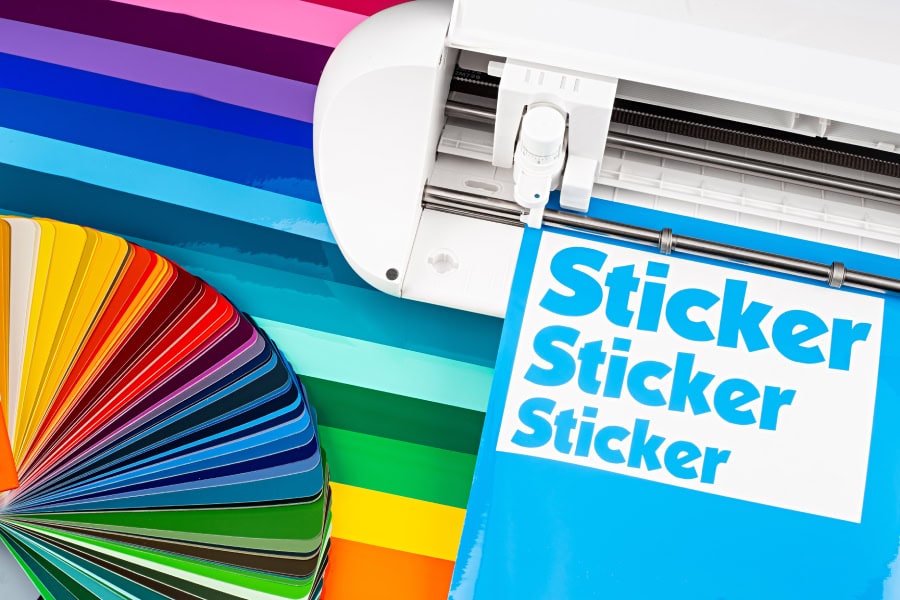Lightning Fast Turnaround!

When you dive into the world of stickers, particularly when it comes to working with a Waco sticker designer, you’ll come across two major kinds: die-cut and kiss-cut. Both are crafted from vinyl, and while they share a common material, their cutting methods and appearances have notable distinctions.
Understanding these differences when shopping for custom stickers, labels, and bumper stickers in Waco is crucial for powerful branding and design. Your choice between die-cut and kiss-cut can have an impact on your project’s aesthetic appeal, practicality, and overall cost.
Below, we’ll explain:
When you compare die-cut and kiss-cut stickers, several key differences emerge that can significantly impact your choice.
Peelability can affect user experience:
Durability factors include:
Understanding these distinctions helps in making an informed decision tailored to specific needs and preferences.
Price difference is a crucial factor when deciding between die-cut and kiss-cut stickers. Both types involve distinct production processes that directly impact their costs.
Design Complexity: Intricate designs may require additional cutting time and precision, affecting overall costs for both sticker types.
Quantity: Larger orders often benefit from economies of scale, lowering the per-unit price.
Given these factors, kiss-cut stickers typically offer a more affordable option due to their simpler production process. However, die-cut stickers provide a unique appeal with their custom shapes and high-quality finish.
When evaluating sticker quality, the cutting method plays a significant role in determining the final product’s appearance and durability. Die-cut stickers are known for their precise, custom shapes. The die-cutting process slices through both the vinyl and its backing, resulting in stickers that perfectly match the design outline without excess material. This method ensures high-quality prints with smooth edges, making them ideal for intricate shapes and standalone designs.
Kiss-cut stickers involve a cutting technique where only the vinyl layer is cut while leaving the backing intact. This allows for easy peeling and application but can sometimes result in less precise edges compared to die-cut stickers. Kiss-cuts are particularly suitable for designs with fine details or multiple elements that need to remain together until applied.
Edge Precision:
Durability:
Both types can achieve high-quality prints if made from premium materials like permanent adhesive vinyl or clear vinyl. When deciding between die-cut and kiss-cut stickers, consider factors like edge precision, ease of application, and specific use cases to ensure you choose the best option for your branding needs.
When it comes to die-cut stickers, creativity knows no bounds. The ability to cut the sticker and its backing into any shape makes these stickers perfect for unique, eye-catching designs. Here are some creative ideas:
Flowers: Embrace nature with detailed floral patterns that can be precisely cut to highlight every petal.
Magical Creatures: Showcase whimsical elements like unicorns, dragons, or fairies. These intricate shapes can captivate audiences and convey a sense of wonder.
Using a custom design tool, you can bring these imaginative concepts to life, ensuring they stand out in any setting.
Kiss-cut stickers offer a different set of advantages, particularly in terms of customization options to enhance brand identity. The intact backing paper allows for additional branding opportunities. Consider these possibilities:
Logos and Minimalist Icons: Ideal for straightforward designs that need to be peeled off easily and used on various surfaces.
Quotes and Slogans: Utilize the extra backing space for adding messages or brand mottos, making them perfect for promotional materials.
Understanding the best use cases for die-cut and kiss-cut stickers can significantly impact your branding strategies.
Both types offer distinct advantages depending on the application. Choosing the right type based on your specific use case ensures optimal performance and brand representation.
Choosing between die-cut and kiss-cut stickers depends on your specific needs and preferences. Each type has its own advantages that suit different applications:
Die-Cut Stickers:
Kiss-Cut Stickers:
Understanding the advantages of die-cut vs kiss-cut can help you decide. Whether you prioritize cost, ease of application, or design complexity, both options offer valuable solutions for effective branding and design.
Die-cut stickers are cut to the exact shape of the design, while kiss-cut stickers have a backing that remains intact around the design, allowing for easy peeling. Understanding these differences is crucial for effective branding and design.
The main differences include the depth of cut, peelability, and durability. Die-cut stickers are cut through the vinyl only, while kiss-cut stickers cut through the vinyl and leave the backing intact. This affects how easily they can be peeled off and their durability against frayed edges and fading.
The production costs for die-cut and kiss-cut stickers vary based on factors such as complexity of the cutting process. Generally, die-cut stickers may be more expensive due to their intricate cutting requirements compared to kiss-cut stickers.
Quality can differ based on the cutting methods used. Die-cut stickers may provide a more polished look due to their precise cuts, while kiss-cut stickers can still offer high-quality prints but may not have the same edge definition.
Die-cut stickers are ideal for uneven surfaces or when you want a unique shape that stands out. Kiss-cut stickers work well for promotional materials that need extra backing, making them easier to handle and apply.
Die-cuts, intricate custom shapes typically designed by a sticker designer in Waco TX, provide a striking visual impact, making them outstand for innovative branding. On the other hand, kiss-cut stickers, convenient with their intact backing, prove exceptionally beneficial for bulk applications or even giveaways, so be sure to ask your sticker designer in Waco TX what options are best for your needs.
|
Uploaded
Failed
|
 |